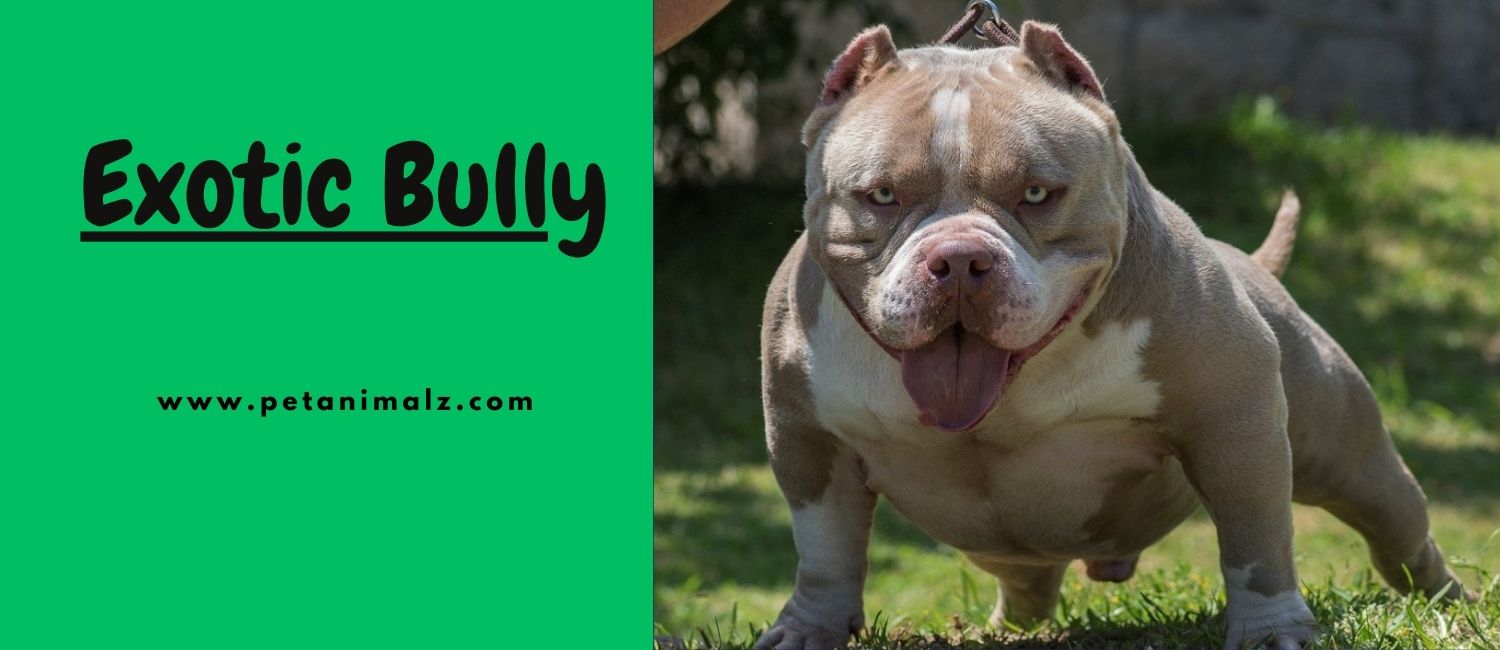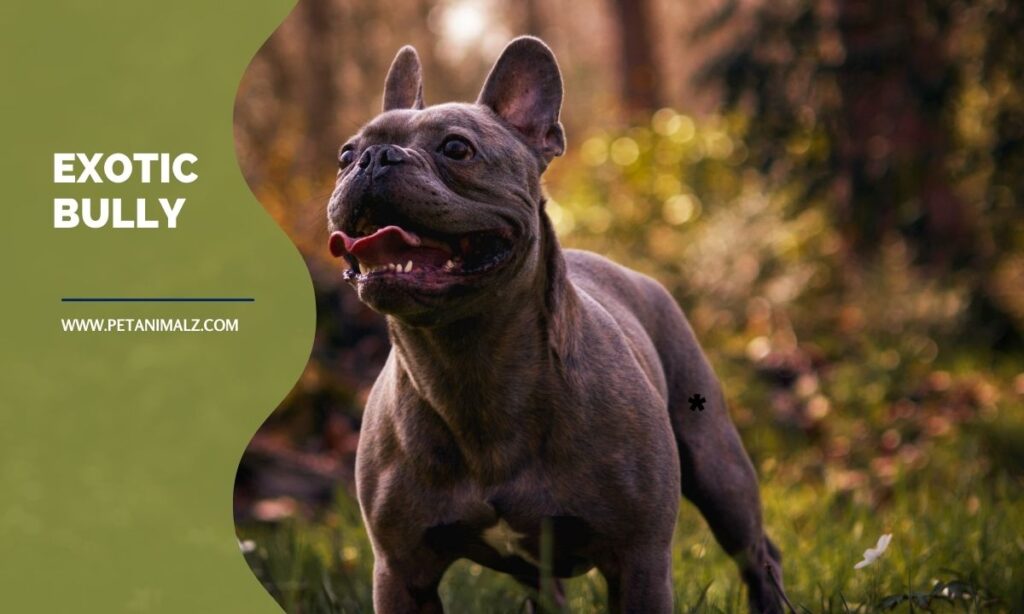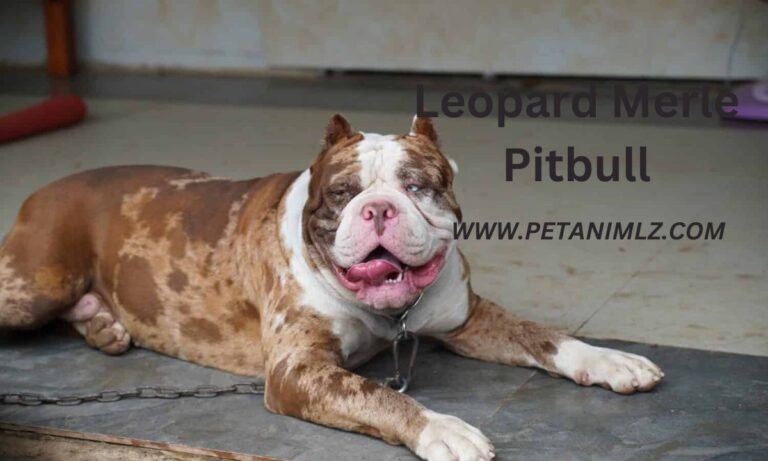What is an Exotic Bully?
Introduction
This article covers all the information about the world of Exotic Bully, a breed that’s as unique as its name. These dogs have been the center of attention in the canine world, sparking both intrigue and controversy.
While some are captivated by their distinct appearance and personality, others question the ethical implications of breeding these dogs. This article aims to shed light on the Exotic Bully breed, giving you an in-depth look at their origins, characteristics, and the debate surrounding them.

What is an Exotic Bully?
The Exotic Bully is a new breed of dog that has been gaining popularity in recent years. They are a variant of the Bully breeds, which include the American Bully, the Bulldog, and the Pit Bull. However, the Exotic Bully stands out due to its unique physical characteristics. They are typically shorter, more muscular, and have a more pronounced bulldog-like appearance compared to their Bully cousins. This breed is known for its friendly nature and loyalty, making them a popular choice for many dog lovers.
History and Origin of Exotic Bullies
The Exotic Bully breed is relatively new, with the first dogs appearing in the early 2000s. They were created by breeders who wanted a Bully dog with a more exaggerated appearance. Despite their recent origin, they have quickly gained recognition from several kennel clubs. However, it’s important to note that not all kennel clubs recognize the Exotic Bully as a distinct breed, leading to some controversy in the dog breeding world.
Physical Appearance of Exotic Bullies
One look at an Exotic Bully and you’ll understand why they’re turning heads. These dogs are known for their robust and muscular bodies, which are complemented by their short stature. They typically stand between 10 to 16 inches tall, making them one of the smaller Bully breeds.
Their heads are large and square-shaped, with short muzzles and wide-set eyes that come in a variety of colors. The ears of an Exotic Bully are usually cropped, giving them a distinctive look.
The Exotic Bully’s coat is another standout feature. It’s short, glossy, and can come in a variety of colors. Common coat colors include black, blue, chocolate, and tri-color. Some Exotic Bullies even have a brindle or merle pattern, adding to their unique appearance.
Despite their tough exterior, Exotic Bullies are known for their gentle and loving nature. They are loyal companions who thrive on human interaction. Their unique physical characteristics, combined with their friendly personality, make the Exotic Bully a truly one-of-a-kind breed.

Understanding the Clean Exotic and the Exotic Bully Lifestyle
What is a Clean Exotic Bully?
A Clean Exotic Bully is a subtype of the Exotic Bully breed. They are characterized by their well-proportioned bodies and lack of excessive features often seen in other Exotic Bullies. The term “clean” refers to their more balanced and less exaggerated physical characteristics, which align more closely with traditional breed standards.
Varieties of Exotic Bullies
There are several varieties of Exotic Bullies, each with their own unique traits. Two of the most popular are the Pocket Exotic Bully and the Micro Exotic Bully.
- Pocket Exotic Bully: This variety is known for its small size. Despite their stature, they are muscular and compact, with all the distinctive features of an Exotic Bully. They are perfect for those who want a smaller dog but still appreciate the unique characteristics of the Exotic Bully breed.
- Micro Exotic Bully: Even smaller than the Pocket variety, the Micro Exotic Bully is the smallest of the breed. They are known for their extremely compact size and muscular build. Despite their small stature, they still possess the friendly and loyal temperament that Exotic Bullies are known for.
Temperament of Exotic Bullies
Exotic Bullies are known for their friendly and outgoing nature. They are great with families and get along well with other pets. Despite their tough appearance, they are gentle and affectionate, making them excellent companions. Their loyalty and protective nature also make them good watchdogs.
Health Issues and Lifespan of Exotic Bullies
Like all breeds, Exotic Bullies can be prone to certain health issues. These can include hip dysplasia, skin problems, and heart conditions. Regular check-ups with a vet are essential to ensure your Exotic Bully stays healthy.
The lifespan of an Exotic Bully typically ranges from 10 to 12 years. This can vary based on factors such as diet, exercise, and overall health.
Care Essentials for Exotic Bullies
Caring for an Exotic Bully involves:
- Food and Diet: A balanced diet is crucial for maintaining their health. High-quality dog food, rich in protein and low in fillers, is recommended.
- Exercise and Physical Activity: Despite their muscular build, Exotic Bullies are not high-energy dogs. Moderate daily exercise is sufficient.
- Cleaning and Grooming: Their short coat is easy to groom. Regular brushing will keep it shiny and healthy. Bathing should be done as needed.
Recognizing the Exotic Bully: Kennel Clubs and Registries
While the Exotic Bully is recognized by several kennel clubs, it’s important to note that not all clubs recognize them as a distinct breed. This includes the American Kennel Club (AKC).
- United Kennel Club (UKC): The UKC recognizes the American Bully, which includes several varieties that could be considered “exotic.” However, it’s important to note that the UKC standards for the American Bully breed may not align with what some breeders consider an “Exotic Bully.”
- American Bully Kennel Club (ABKC): The ABKC recognizes the American Bully and has been instrumental in standardizing the breed. They recognize several varieties of the American Bully, which may include dogs that some consider “exotic.”
- The Bully Registry Company (BRC Global): BRC Global recognizes a variety of Bully breeds, including the Exotic Bully.
- International Bully Coalition (IBC): The IBC recognizes the Exotic Bully and has a specific class for them in their shows.
- Worldwide Bully Registry (WBR): The WBR recognizes the Exotic Bully and has specific standards for them.
So, What Do the Registries Agree Upon?
As of my last training data in September 2021, there isn’t a universal agreement among all registries about the Exotic Bully breed. This is largely due to the breed’s relatively recent emergence and the controversy surrounding its breeding practices. However, there are a few points that many registries tend to agree upon:
- Breed Origin: Most registries agree that the Exotic Bully originated from the American Bully, which itself is a derivative of the American Pit Bull Terrier and the American Staffordshire Terrier.
- Physical Characteristics: Registries often agree on certain physical characteristics of the Exotic Bully, such as their compact size, muscular build, and distinctive head shape. However, the degree of exaggeration in these features can vary between registries.
- Temperament: There’s general agreement that Exotic Bullies, like other Bully breeds, should have a friendly and outgoing temperament. They’re often described as being good with families and other pets.
v
Most Interesting Facts About The Blue Nose Pit Bull
The Blue Nose Pit Bull is a type of American Pit Bull Terrier that is particularly sought after due to its unique coloring. Here are some interesting facts about this breed:
- Unique Coloring: The term “Blue Nose Pit Bull” doesn’t refer to a separate breed, but rather to an American Pit Bull Terrier with a specific coloration. They have a blue-grey coat and a matching blue-grey nose, which is where their name comes from.
- Not Always Blue: Despite their name, not all Blue Nose Pit Bulls have a blue nose. Some may have a red or a partially blue nose, and they can still be considered part of the “Blue Nose” variety.
- Rare Genetics: The blue color in Blue Nose Pit Bulls comes from a recessive gene, which makes this coloration relatively rare. Both parents must carry the gene for a puppy to potentially have this coloration.
- Same Temperament: Blue Nose Pit Bulls have the same temperament as any other American Pit Bull Terrier. They are known for their intelligence, energy, and affectionate nature.
- Health Issues: Blue Nose Pit Bulls, like other dogs with rare coloration, can be more prone to certain health issues. This includes skin problems and immune system disorders. It’s important to ensure that any Blue Nose Pit Bull puppy you consider adopting has been health-checked and comes from a reputable breeder.
- Not a Guarantee: Breeding two Blue Nose Pit Bulls does not guarantee that all the puppies will also be Blue Nose. The genetics of coat color in dogs is complex and depends on multiple factors.
Cost and Adoption of Exotic Bullies
The cost of an Exotic Bully can vary greatly, ranging from $2000 to $10,000 depending on the breeder, lineage, and specific characteristics of the dog. Adoption is also an option, with many rescue organizations having Exotic Bullies looking for a forever home.
FAQs
What breeds make up an Exotic Bully?
The Exotic Bully is a mix of several breeds, primarily the American Bully, American Bulldog, and English Bulldog.
Is it recommended that first-time owners get an Exotic Bully?
Yes, their friendly and easygoing nature makes them suitable for first-time owners.
Are Exotic Bullies aggressive?
No, despite their tough appearance, Exotic Bullies are known for their gentle and friendly nature.
How many distinct forms of bullying are there to choose from?
There are several varieties of Exotic Bullies, including the Standard, Pocket, and Micro.
What is the difference between American Bully and Exotic Bully?
The American Bully and the Exotic Bully are both breeds that originated from the American Pit Bull Terrier and the American Staffordshire Terrier. However, the Exotic Bully is a more recent breed and is characterized by its unique physical features. They are typically shorter, more muscular, and have a more pronounced bulldog-like appearance compared to the American Bully.
What is a clean Exotic Bully?
A Clean Exotic Bully is a subtype of the Exotic Bully breed. They are characterized by their well-proportioned bodies and lack of excessive features often seen in other Exotic Bullies. The term “clean” refers to their more balanced and less exaggerated physical characteristics, which align more closely with traditional breed standards.
What are the characteristics of an Exotic Bully?
Exotic Bullies are known for their robust and muscular bodies, which are complemented by their short stature. Their heads are large and square-shaped, with short muzzles and wide-set eyes. The Exotic Bully’s coat is short, glossy, and can come in a variety of colors. Despite their tough exterior, Exotic Bullies are known for their gentle and loving nature.
How tall is a Micro Bully?
The Micro Bully, a subtype of the Exotic Bully, is the smallest of the breed. They typically stand between 10 to 13 inches tall.
What breed is closest to American Bully?
The breed closest to the American Bully is the American Pit Bull Terrier. The American Bully was originally bred from the American Pit Bull Terrier and the American Staffordshire Terrier, and they share many physical and temperamental characteristics.
What are the 4 bully breeds?
The term “bully breed” is used to refer to a type of dog that originated from molosser dogs, which are large, muscular dogs with a particular type of head shape. The four most well-known bully breeds are the American Pit Bull Terrier, the American Staffordshire Terrier, the Staffordshire Bull Terrier, and the American Bully. However, there are many other breeds that fall under the “bully breed” category, including the Boxer, Bulldog, and Boston Terrier.
Conclusion
The world of Exotic Bullies is as diverse as it is fascinating. From the compact Micro Exotic Bully to the well-proportioned Clean Exotic, there’s a variety to suit every preference. Despite the controversy surrounding their breeding, there’s no denying the appeal of these unique dogs. Their distinctive appearance, coupled with their friendly and loyal nature, makes them a standout choice for many dog lovers.
However, owning an Exotic Bully is a responsibility not to be taken lightly. From understanding their health issues to providing the right care, it’s essential to be well-informed before bringing one of these dogs into your home. Whether you’re a first-time owner or a seasoned dog lover, the Exotic Bully offers a unique pet-owning experience that’s rewarding in its own right.
In the end, the Exotic Bully is more than just a breed—it’s a testament to the diverse and ever-evolving world of dogs. And for those who choose to welcome an Exotic Bully into their lives, it’s a journey filled with companionship, love, and a whole lot of personality.




